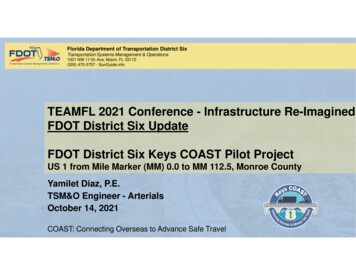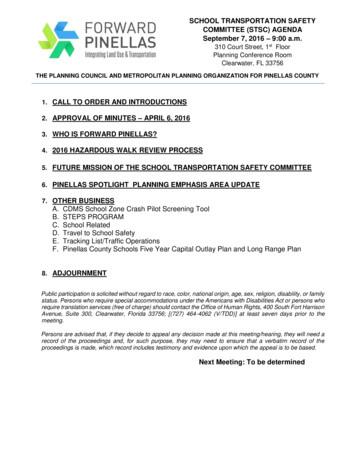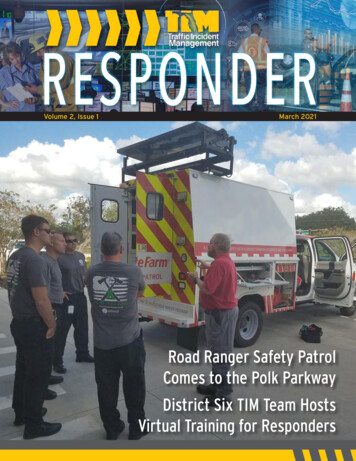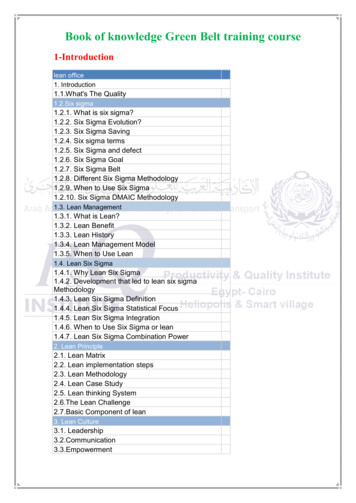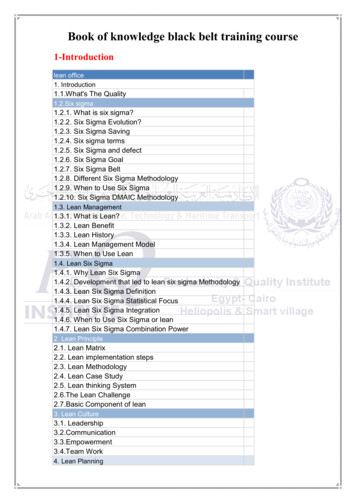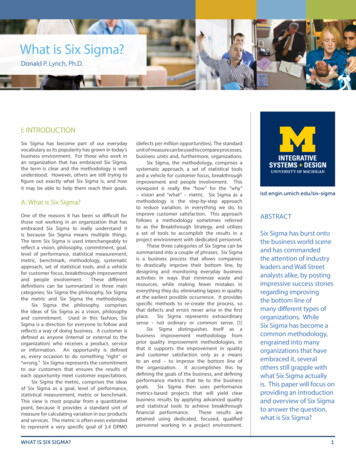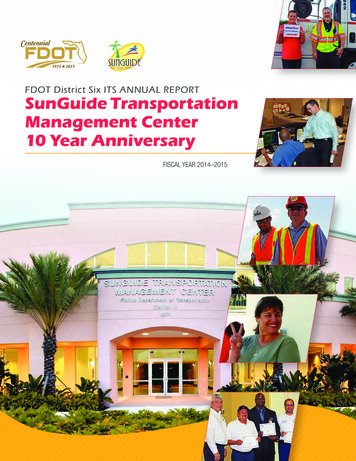
Transcription
FDOT District Six ITS ANNUAL REPORTSunGuide TransportationManagement Center10 Year AnniversaryFISCAL YEAR 2014–2015
A MESSAGE FROM THE DISTRICT SECRETARYA lot can happen in ten years. New presidents are elected. Technology continues to change at arapid pace. Significant weather events take place. However, one constant has been the increasein traffic volumes and congestion in the South Florida region. There have been significanttransportation improvement projects designed and constructed to improve traffic conditionsincluding the construction of the Miami Intermodal Center, Port of Miami Tunnel, expansionsalong the Palmetto Expressway, and major improvements to the Palmetto Expressway / DolphinExpressway Interchange. However, Intelligent Transportation Systems (ITS) continue to play animportant role with optimizing our infrastructure and managing congestion. Ten years ago, theSunGuide Transportation Management Center (STMC) was constructed to manage the expandingITS network. This edition of the ITS Annual Report celebrates the tenth anniversary of the STMC.First, a brief history leading to the need for the STMC. Duringthe early 1990s, it was clear that we could not build our wayout of traffic congestion. Our existing roadway infrastructureneeded to be managed more efficiently. At the time, the FederalHighway Administration had begun to develop the IntelligentVehicle Highway System (IVHS) program. IVHS was a product ofthe landmark Intermodal Surface Transportation Efficiency Act of1991 (ISTEA). One of the tenets of IVHS was to “provide for theaccelerated use of advanced technology to improve safety on allroads and to reduce traffic congestion along heavily populated andtraveled corridors.”The Florida Department of Transportation (FDOT) began dippingits toe in the intelligent highway pool. In District Six, there werea few pilot projects including the first closed circuit television(CCTV) camera project and the dynamic message sign (DMS)technology demonstration project—both within the GoldenGlades Interchange. The first major project was the IntelligentCorridor System (ICS) along the entire 17 mile portion of I-95 inMiami-Dade County which started in 1997. This project includedinstallation of the fiber optic cable communications backbone,CCTV cameras, freeway dynamic message signs, and a combinationof inductive loop and video detectors. This was the catalyst for thesystem deployment of what would become known as the ITS alongthe main freeways in District Six including I-95, I-195, I-395, I-75,the Palmetto Expressway, and US-1 (the major arterial from MiamiDade County to Key West).The master plan of the ICS included a central control center whichwould allow staff to monitor the data being transmitted by thefield devices and transmit messages to motorists about trafficconditions. The first ICS project established an Interim OperationsCenter (IOC) at the District Six headquarters building. The IOCremained in operation while the STMC was constructed. TheSTMC opened its doors on June 25, 2004.Gus Pego, P.E.District Six Secretary of the Florida Department of TransportationThe building was constructed with growth in mind and housesthe TMC for our sister agency, the Miami-Dade ExpresswayAuthority (MDX) and the regional dispatch center for FloridaHighway Patrol (FHP) Troop E. Through the years, the STMChas helped to facilitate the implementation of several importantprojects including our freeway service patrol or Road Rangers,the installation of the first express lanes system in Florida,the installation of the first ramp signal system in Florida, theimplementation of the Rapid Incident Scene Clearance (RISC)program, and several other innovative projects.The STMC will continue to support future projects and initiatives.We have the potential for improving the reliability of ourtransportation system through efficient operations. Based on thesix-year operational success of the 95 Express, District Six hasbeen planning the development of a regional network of expresslanes to improve mobility within Southeast Florida. District Six isworking closely with its partners in expanding the express lanesprogram to other strategic corridors including SR 826, I-75 aswell as continuation of the 95 Express through Broward and PalmBeach Counties. The STMC is expanding to support these newinitiatives by increasing the amount of operator work stationsfrom eight to eighteen.I would like to thank our ITS Leadership team, consultants,contractors, and all the past contributors for the sustainedsuccess of our program. These incredibly dedicated people workconstantly to make the District Six ITS program, including the 95Express, an international success.As District Six Secretary, I am proud of our accomplishmentsthis past year and am fortunate to witness the evolution of theSTMC over the last ten years. I look forward to the next ten yearsand making our multimodal transportation system the best inthe nation of which the SunGuide TMC is a key component ofachieving that goal.
TABLE OF CONTENTSINTRODUCTION.2ITS DEPLOYMENTS.3TMC OPERATIONS.4INCIDENT MANAGEMENT.7IT / ITS MAINTENANCE.9TRAVELER INFORMATION. 10PUBLIC OUTREACH. 11BENEFITS TO THE PUBLIC. 12A LOOK AHEAD. 13FDOT District Six ITS Annual Report 2014-2015 1
INTRODUCTIONThe theme for this year’s annual report is the ten year anniversaryof the SunGuide Transportation Management Center (STMC)and what it means to South Florida. The ITS program has seenmany changes over the past ten years and the STMC has been thecornerstone for these changes.The ITS program had its genesis in the mid 1990s with theinstallation of the first dynamic messages sign (DMS) projectwithin the Golden Glades Interchange (the intersection of I-95,the Florida’s Turnpike, the Palmetto Expressway, and SR 7).This was followed by the first closed circuit television (CCTV)camera project also within the Golden Glades Interchange. Theseprojects were the launching point for the current vibrant ITSprogram that is in place today. The STMC was constructed as partof the I-95 Intelligent Corridor System. The STMC replaced theinterim operation center that was housed in the FDOT District Sixheadquarters building.The STMC was designed to be the focal point and command centerfor ITS operations in District Six. This 32,000 square foot buildingalso houses operations anddispatching for the MiamiDade Expressway Authority,Florida Highway Patrol TroopE, Florida Fish and WildlifeConservation Commission,and the Florida Department ofLaw Enforcement.Interim Operations Center, 2000The STMC and its staff havemanaged the expansion ofITS equipment along themajor freeways in MiamiDade County including US-1through Monroe Countyto Key West. Innovationssuch as the 95 Express havebeen managed successfullyGroundbreaking at theSTMC site, 2001from the center. The needto continually optimize ouroperations coupled with the expected growth in ITS deploymentand expansion of the regional express lanes network hasnecessitated a retrofit of the control room. The STMC embarkedon a project to increase the number of operator workstations fromeight to eighteen.This FDOT District Six ITS Annual Report covers the timeframefrom July 1, 2014 to June 30, 2015 (FY 2014–2015). This ITSAnnual Report aligns with the program’s five primary functionalareas listed below:ITS DEPLOYMENTS. providing planning, design and procurementof ITS equipment, including CCTV cameras, DMS, vehicledetectors, and communications supporting ITS operations.TMC OPERATIONS. providing a central location for data collectionand dissemination. The STMC is the command center formanaging traffic incidents as well as providing proactiveoperations through express lanes, ramp signaling, and otheractive traffic management strategies.INCIDENT MANAGEMENT. providing and dispatching RoadRangers, and other incident management resources, to safelyand quickly clear lane-blocking events as well as providemotorist assistance. An important part of the program iscoordination with first responders to identify, develop andimplement solutions to improve incident management.IT/ITS MAINTENANCE. managing the maintenance of ITS fieldand STMC equipment to ensure system availability and stability,as well as provide software support.TRAVELER INFORMATION. providing real-time travelerinformation services through various media, such as thetelephone, Internet, Smartphone applications, and social media.This marks the tenth edition ofDistrict Six’s ITS Annual Report.In this report, we highlightsome of the history and how theDistrict Six ITS office focusedits efforts on enhancing itsoperational strategies, software,and coordination efforts.We hope you find the reportinformative and welcome you tojoin District Six as we continueto improve the reliability ofthe multi-modal transportationsystems within South Florida.Future Control Room, 2015FLORIDA DEPARTMENT OF TRANSPORTATIONITS MISSION:Enhance the safety, security and efficiency of Florida’s transportationsystem through the implementation of interoperable ITS technology insupport of local, regional and statewide mobility.2 ITS VISION:Be the national leader in ITS by promoting multi-jurisdictionalcoordination for the provision of an efficient, secure, reliable, and safetransportation system.SunGuide Transportation Management Center 10 Year Anniversary
ITS DEPLOYMENTSThe first ITS projects concentrated on installing the outdoor plantfiber optic cable infrastructure and expansion of CCTV cameras,traffic detectors, and dynamic message signs in Miami-Dade andMonroe Counties. As ITS was embraced as a traffic improvementoption, FDOT road and bridge projects continued the deploymentby including ITS elements in these construction projects. ITSbecame an important consideration in planning and feasibilitystudies for new roadway projects. One of the challenges with ITSis the ever-changing technology. Over the past 10 years therehave been improvements to CCTV cameras with high definitionvideo, DMS are being installed with the capability of full colortext and graphics, and communications have improved to usingboth hard-wired and reliable wireless systems. District Six hasworked hard to stay ahead of the technology curve and continuesto improve the ITS infrastructure to achieve its transportationgoals in improving traffic safety, incident management, mobility,and reliability.Some of the significant historic ITS projects include:I-95 INTELLIGENT CORRIDOR SYSTEM (PACKAGES A, B, AND C).This was the first majordeployment of ITS inMiami-Dade Countycovering the entire17 mile portion ofI-95. Packages A & Bestablished the fiberoptic cable backbone;installed CCTVFreeway DMS along I-95cameras, DMS, anddetectors; installed theramp signal infrastructure; and laid the foundation for the I-95express lane projects. Package C was the project that constructedthe STMC. These projects began in 1997 and were completedin 2007.95 EXPRESS PHASE 1. This project was the beginning of FDOT’sinvolvement with express lanes. The project converted theHigh Occupancy Vehicle (HOV) lane and adjusted overall lanewidths to install two express lanes in each direction over aseven mile segment of I-95. The northbound segment becameoperational in 2008 and the southbound segment in 2010.I-95 RAMP SIGNALS. District Six deployed the first rampsignals in Florida at 22 on-ramps along I-95. The first phasealong northbound I-95 from NW 62nd Street to Ives DairyRoad became operational in 2008. The second phase alongsouthbound I-95 became operational in 2009. This systemhas proven successful in smoothing friction points betweenfreeway and merging traffic.FDOT District Six ITS Annual Report 2014-2015A summary of District Six ITS projects completed during FY 2014–2015 and ongoing into FY 2015–2016 includes:DMS AND ARTERIAL DMS REPLACEMENTS. These design-buildprojects replaced five amber freeway DMSs and three amberarterial DMSs with color LED full-matrix DMSs. The DMSproject was completed in July 2014 and the arterial DMS projectwas completed in April 2015.SR 826 AND I-75 EXPRESS LANES MIAMI-DADE DEPLOYMENTS.These express lane projects began construction during 2014.ITS devices such as CCTV cameras, DMS, vehicle detectors, andother infrastructure support equipment will be installed tosupport these express lanes. These projects are scheduled forcompletion in 2017.PALMETTO EXPRESSWAY (SR 826)/DOLPHIN EXPRESSWAY(SR 836) INTERCHANGE RECONSTRUCTION SECTION 5. Thismajor multilevel interchange reconstruction project includesadditional ITS elements such as five new CCTV cameras, DMSsalong SR 826, arterial DMSs, microwave vehicle detectors,and fiber optic cables. The addition of these devices willprovide District Six with full coverage of the SR 826/SR 836Interchange and completes the final fiber optic cable link for SR826. Construction has been ongoing since 2009 and is expectedto be complete in 2016.95 EXPRESS PHASE 2. This project, which began constructionin November 2011, will extend the existing express lanesfrom the Golden Glades Interchange in Miami-Dade Countyto Broward Boulevard in Broward County. ITS devicessuch as CCTV cameras, DMSs, vehicle detectors, and otherinfrastructure support equipment will be installed to support95 Express Phase 2. This project is scheduled for completionin 2016.I-95 EXPRESS DMS AND TOLL SIGN PANEL REPLACEMENTPROJECT. This project beginning in FY 2015–2016 willretrofit existing toll signs, DMS, and confirmation camerasfor the express lanes expansion. The project will upgrade theequipment to high definition (HD) cameras and full matrixcolor DMS. This will enhance the existing express lanes andallow for the expansion under the 95 Express Phase 2 project.This table illustrates theincrease in deployed ITSdevices from 2005 to 2015.ITS amp Signals 3
TMC OPERATIONSThe origin of the ITS program was a result of the transitionfrom development of advanced traffic signal systems to freewaymanagement. During the planning stage, it became apparentthat a command center needed to be established to handle theamount of data being received and the information being sentout. The ICS Package A Project established the interim operationscenter (IOC) in the District Six headquarters building. This wasa temporary base of operations until the STMC building couldbe constructed. The ICS Package C project constructed the STMCbuilding which was followed by another project to install thenetworking, computer, and video wall equipment. The fullyfunctional STMC became operational on June 25, 2004 and theDistrict Six ITS program has not looked back.The STMC serves as the command and control center for proactivetraffic management (e.g., express lanes, ramp signaling) as well asits core functions of incident, work zone, emergency, and specialevent management. The STMC operates 24 hours a day, seven daysa week.The STMC has also accommodatedadvancements in software. The first ITSsoftware system used in District Six wasbased on proprietary software. As eachdistrict started installing ITS equipment,the FDOT Central Office embarked ondeveloping standard software that would be used by all districts.Hence, the SunGuide system software was born. Today all FDOTdistricts, including the Florida’s Turnpike, use the SunGuidesoftware.District Six had additional requirements and needs that wentbeyond what the SunGuide software could provide. The decisionwas made to develop software tools to help with the day-today operations. District Six developed Operations Task Manager(OTM) and Operator Quality Control (OpQC) to assist withfunctions such as express lanes operation, tracking ITS devicemaintenance tickets, measuring operations staff performance, andother daily activities. This software helps District Six operate moreefficiently.TMC operators coordinate with emergency responders, RoadRangers, and other incident management resources to clearincidents as quickly and safely as possible from South Florida’sroadways. This coordination is enhanced by the co-location of theMiami-Dade Expressway Authority (MDX) TMC operations staffand the Florida Highway Patrol (FHP) Troop E dispatch withinthe STMC.The SunGuide software was upgraded to Version 6.0 whichincludes new features to accommodate Wrong Way Detectionsystems, enhancement to WAZE operations, and transition toa Windows platform to enable TMC Operators to make moreinformed decisions in activating incident response plans.4 95 EXPRESS OPERATIONSOne of themost significantprojects toimpact ITSoperationsduring thepast ten yearsis the ExpressLanes Phase 1project. The95 Express Lanesproject launchedin December2008 and has seen a steady increase in popularity in South Floridaleading it to be considered one of the most successful and highlyused express lanes facilities in the United States. During FY2014–2015, the 95 Express reached 120 million vehicle trips sinceinception and serviced over 21 million vehicle trips during thepast year.Toll-exempt trips using the 95 Express (i.e., carpools of three ormore and transit) experienced a significant increase from 560,000to over 680,000 trips, a 21% increase. Of all toll-exempt trips,30% are composed of HOV3 . Express Lanes Bus Rapid Transitservice also experienced increased usage during FY 2014–2015rising from 2,810 to 3,537 boardings per day, a 25% increase.This graphhighlights thereliability ofthe 95 Express.Reliability is akey performancemeasure for theExpress Lanesand is defined asthe percentageof time duringthe peak periodwhen speedsremain above 45 miles per hour. The federal goal for thisperformance measure is 90%. The northbound afternoon peakperiod has several factors affecting reliability including: moreconcentrated traffic volumes for homebound commuters, conflictpoint at the Golden Glades Interchange, and freeway geometryissues north of the I-195 interchange.As a result of the decrease in reliability, District Six experimentedwith a hard closure procedure for the northbound PM peakperiod. Any traffic event within the express lanes during thePM peak period would result in physically shutting down theentrances to the express lanes. This was implemented to controlaccess to the facility, manage motorists ignoring a posted “closed”SunGuide Transportation Management Center 10 Year Anniversary
message under a “soft closure”, prevent “lane divers” fromweaving between the express lane markers, and improve safety forresponders. This procedure is currently being evaluated.As the District continues to operate the existing phase of the 95Express, it is also working with its partners District Four andFlorida’s Turnpike preparing for the next phase of the facility. 95Express Phase 2, which is currently under construction and isscheduled to begin operations during FY 2015–2016, is a 14mile extension from the current phase into Broward County.Upon completion, this new phase will introduce two new tollingsegments in each direction. Drivers who wish to use 95 Express forlong trips will benefit from “Trip Building” based operations. Tripbuilding allows drivers to see a toll (or tolls) for longer distancesrather than one exit ahead and locks them at the price shown (orlower) based on the time their toll transponder is read at the firsttolling point passed. As part of the effort to make this transitionseamless for drivers, District Six worked with its partners todevelop business rules which were translated into software designrequirements to accommodate the new type of operations.SR 826/I-75 EXPRESS OPERATIONSDistrict Six is expanding its express lanes network in alignmentwith a regional plan established for South Florida. After 95 ExpressPhase 2, the next express lanes project to become operational forDistrict Six is the SR 826/I-75 Express Lanes. The project limits areSR 826 from West Flagler Street to NW 154th Street continuingalong I-75 from SR 826 to I-595 in Broward County. The projectlength is approximately 28 miles and spans FDOT Districts Fourand Six.The SR 826/I-75 Express Lanes will include a two-lane directconnect reversible flyover ramp to/from the I-595 ExpressReversible Lanes System in the northern end of the project inBroward County. There will also be a single-lane flyover ramp thatconnects the southbound I-75 Express Lanes to the southboundHomestead Extension of the Florida’s Turnpike (HEFT), anda single-lane flyover that connects northbound HEFT to thenorthbound I-75 Express Lanes. There will be a flyover ramp(one lane in both the northbound and southbound directions)that directly connects I-75 and SR 826. In addition to the physicalgeometric improvements, the SR 826/I-75 Express Lanes will alsoinclude the following additional system components: Dynamic Message Signs System Vehicle Detection System CCTV Cameras System Ramp Signal System (SR 826 only) FDOT Toll Setting Software Electronic Toll Collection System Reversible Lane Control System Incident Management ServicesOperation of the SR 826/I-75 Express Lanes will be a joint effortbetween the TMCs in Districts Four and Six. Both TMCs will usethe statewide SunGuide Software to monitor and control the ITSfield devices. The toll operations functionality will be controlledthrough separate software that will interface with the SunGuideSoftware and the Florida’s Turnpike back office software. Inaddition, Florida Highway Patrol (FHP) and local police/firerescue agencies will provide emergency response. The FHP willalso be responsible for enforcement.RAMP SIGNALING OPERATIONSAnother component of the 95 Express is theramp signaling system, which entered itsfifth full year of operation during FY 2014–2015. Consisting of 22 total ramp signals, thesystem improves operations along I-95 byregulating the flow of vehicles entering theroadway during peak periods of travel. TMCoperators can also activate the ramp signalingsystem in the case of congestion duringnon-peak periods or to assist during anincident or special event. As demand alongthe freeway increases in the future, rampsignaling will continue to be one of the toolsto help District Six continue to be proactivein managing congestion. This graph indicatesthe decrease in average travel times alongI-95 from before the ramp signaling system’s implementation (2008) toafter its implementation (northbound in 2009 and southbound in 2010).FDOT District Six ITS Annual Report 2014-2015 5
CONSTRUCTION AND SPECIAL EVENTCOORDINATIONA crucial component of TMC operations is coordinating withmultiple agencies to ensure all planned and unplanned laneblockage events are dealt with in the most efficient mannerpossible. During FY 2014–2015, coordination between the TMCoperations staff and these various agencies increased as severalconstruction projects continued to affect District Six roadways.CONSTRUCTION COORDINATION. One of the most significantchallenges is the impact of ongoing roadway construction. TMCoperations staff coordinated with the project leads of severalconstruction projects to create pre-event information plans thatwould advise the motoring public of upcoming constructionrelated closures. The following is a list of projects that TMCoperations staff developed these plans for: SR 826/836 Section 5,NW 25th Street Viaduct Phase 2, I-95 Pavement Rehabilitation,Long Key Bridge Pier Replacement, I-75 and SR 826 Express Lanes,and 95 Express Phase 2.SPECIAL EVENT COORDINATION. Aside from constructionprojects, several special events occur in South Florida thatcause unusual traffic congestion along District Six roadways.TMC operations staff coordinates with representatives of theseevents to help ensure traffic can move as safely and efficiently aspossible. Events such as the annual holiday Toys in the Sun Runin Broward County, professional basketball games in downtownMiami, a major tennis tournament in Key Biscayne, all collegeand professional football-related events including the college bowlgame at the stadium in North Miami, and downtown Miamientertainment events (e.g., weekend long music festivals) are justa few examples of events TMC operations staff handled.SOFTWARE ENHANCEMENTSDuring FY 2014–2015, TMC operations software was enhancedto streamline procedures, increase operational efficiency, andprovide optimized quality assurance and quality control of TMCoperator data entry.OPERATIONS TASK MANAGER (OTM). OTM is a single piece ofsoftware that incorporates several separate software moduleswhich serve as extensions of the statewide SunGuide Software.OTM includes ten modules handling functions such as expresslanes, ramp signaling, ITS device maintenance tracking, rapidincident scene clearance, and reporting functions. During FY2014–2015, OTM was improved to accommodate the upgradeto the new SunGuide version 6.0 and enhance the expresslanes module.OPERATOR PERFORMANCE QUALITY CONTROL (OPQC).The TMC’s operational services are provided through aperformance-based contract, in which operator performanceis evaluated on 34 possible errors for each lane blocking eventmanaged. This requires a detailed quality review of all travel laneblocking events. OpQC was developed to help automate most ofthe data evaluation efforts for both lane blockage and non-laneblockage events. In FY 2014–2015, staff incorporated OpQC as amodule in OTM.PERFORMANCE MEASURESIn December 2007, District Six set targets for keyoperational performance measures that have the greatestimpact to the public. During FY 2014–2015, TMCoperations staff once again exceeded those targets, thanksto quality control procedures that include daily reviews ofall travel lane blocking events.The table on the opposite page shows the performancemeasures’ average results and targets. These goals continueto be exceeded as operators managed 49,500 total eventsand 19,000 lane blocking events during FY 2014–2015.The adjacent graph shows the number of events comparedto previous years.6 SunGuide Transportation Management Center 10 Year Anniversary
Performance MeasuresDMS EfficiencyTMC Operator Error RateFY 07-08AverageFY 08-09AverageFY 09-10AverageFY 10-11AverageFY 11-12AverageFY 12-13AverageFY 13-14AverageFY 9.87%99.78%99.74% 95.00%0.19%0.30%0.43%0.32%0.30%0.36%0.38%0.44%Time to Dispatch Road 00:00:4400:00:45 00:02:00 0.59%Time to Confirm an 0:01:4800:01:11 00:02:00Time to Post 02:2800:02:16 00:05:00Time to Notify Other 3000:01:4200:02:18 00:07:00INCIDENT MANAGEMENTDistrict Six’s incident management service helps maintainroadways free and clear of road blocking incidents. The multiagency Traffic Incident Management (TIM) Team plays asignificant role in helping FDOT to reach its goal: to reduce trafficcongestion, as well as decrease the chances of secondary events,caused by prolonged exposure to traffic incidents.With the help of all its partners in the TIM Team, District Six’saverage annual roadway clearance time was 27.5 minutes duringFY 2014–2015. The following graph shows the historic trend ofroadway clearance times.outreach with partnering agencies. Meetings were arranged withseveral agencies within the TIM Team such as FHP, Road Rangercontractors, roadway maintenance contractors and fire rescuerepresentatives. The group discusses upcoming FDOT projects aswell as conducts post incident analyses of recent large scale eventsto apply lessons learned. FHP Troop E and TMC operations staffcontinue to share information and resources to help detect andmanage incidents along District Six roadways more efficiently. Therelationships built in the TIM Team help District Six by creatingmore efficient interagency coordination during future incidentsalong general purpose lanes as well as express lanes.ROAD RANGERSThe TMC serves as the control center for dispatching andcoordinating field operations. One of the largest parts of DistrictSix’s field operations is the Road Ranger program, which began in1999 and has evolved into an incident management arm for theSTMC. As the most visible component of District Six’s incidentmanagement service, Road Rangers provide incident responseand motorist assistance along I-95, I-75, SR 826, I-195, I-395 andthe MacArthur Causeway. The initial vehicles included tow trucksand pickup trucks. In 2009, flatbed wreckers were added andin 2013 a heavy duty wrecker was implemented. As seen on thepie chart below, more than 90% of Road Ranger assists are forMaintenance of Traffic (MOT), repair or clearance services.TIMSpecial event coordination was a major component of incidentmanagement efforts during FY 2014–2015. Interagencycoordination within the TIM Team made that possible.Thanks to the relationships built within the TIM Team, the TMC’sTIM representatives were able to continue coordination efforts andFDOT District Six ITS Annual Report 2014-2015 7
INCIDENT RESPONSE VEHICLES (IRV)SAFETY AND SIRV COORDINATIONDistrict Six continued coordination between its IRV operationsstaff and the District Four TMC’s Severe Incident Response Vehicle(SIRV) Team. This coordination is needed due to the overlappingconstruction limits for the 95 Express Phase 2 project. The twoteams meet and discuss IRV/SIRV procedures and lessons learned.Coordination will continue through the opening of 95 ExpressP
the landmark Intermodal Surface Transportation Efficiency Act of 1991 (ISTEA). One of the tenets of IVHS was to "provide for the accelerated use of advanced technology to improve safety on all roads and to reduce traffic congestion along heavily populated and traveled corridors." The Florida Department of Transportation (FDOT) began dipping
